Metatranscriptome Analysis of Sheep Rumen Reveals Methane Production Changes Induced by Moringa oleifera as a Dietary Supplement
Abstract
1. Introduction
2. Materials and Methods
2.1. Bromatological Characterization of Moringa oleifera
2.2. Rumen Fluid Collection and In Vitro Fermentation
2.3. RNA Extraction
2.4. Sequencing, Data Preprocessing, and Assembly
2.5. Taxonomic Characterization, Functional Analysis, Differential Analysis, and Enrichment Analysis
3. Results
3.1. RNA Sequencing, Mapping, and Taxonomic Characterization
3.2. Functional Analysis
3.3. Enrichment Analysis
3.4. Differential Expression Analysis
4. Discussion
5. Conclusions
Author Contributions
Funding
Institutional Review Board Statement
Informed Consent Statement
Data Availability Statement
Acknowledgments
Conflicts of Interest
Appendix A
| T0_1 | T0_2 | T1_1 | T1_2 | T2_1 | T2_2 | |||||||
|---|---|---|---|---|---|---|---|---|---|---|---|---|
| Kingdom | Abund | % | Abund | % | Abund | % | Abund | % | Abund | % | Abund | % |
| Archaea | 94,929 | 0.13 | 213,475 | 0.28 | 79,319 | 0.13 | 43,708 | 0.06 | 12,361 | 0.01 | 2,642,305 | 3.20 |
| Bacteria | 52,788,118 | 72.13 | 47,159,577 | 61.75 | 31,529,695 | 51.32 | 61,086,512 | 79.69 | 60,309,727 | 70.09 | 36,331,623 | 44.01 |
| Eukaryota | 757,736 | 1.04 | 914,792 | 1.20 | 1,008,417 | 1.64 | 948,293 | 1.24 | 563,586 | 0.66 | 471,579 | 0.57 |
| No CDS | 2,286,794 | 3.12 | 4,869,970 | 6.38 | 141,358 | 0.23 | 995,763 | 1.30 | 5,092,198 | 5.92 | 13,700,976 | 16.60 |
| Unclassified | 14,873,143 | 20.32 | 19,238,680 | 25.19 | 14,144,528 | 23.02 | 8,238,457 | 10.75 | 17,582,487 | 20.43 | 24,136,574 | 29.24 |
| Unmapped | 1,967,888 | 2.69 | 3,402,342 | 4.46 | 10,210,295 | 16.62 | 3,584,305 | 4.68 | 2,316,878 | 2.69 | 3,603,330 | 4.36 |
| Virus | 413,614 | 0.57 | 572,216 | 0.75 | 4,321,728 | 7.03 | 1,758,878 | 2.29 | 166,223 | 0.19 | 1,673,033 | 2.03 |
Appendix B

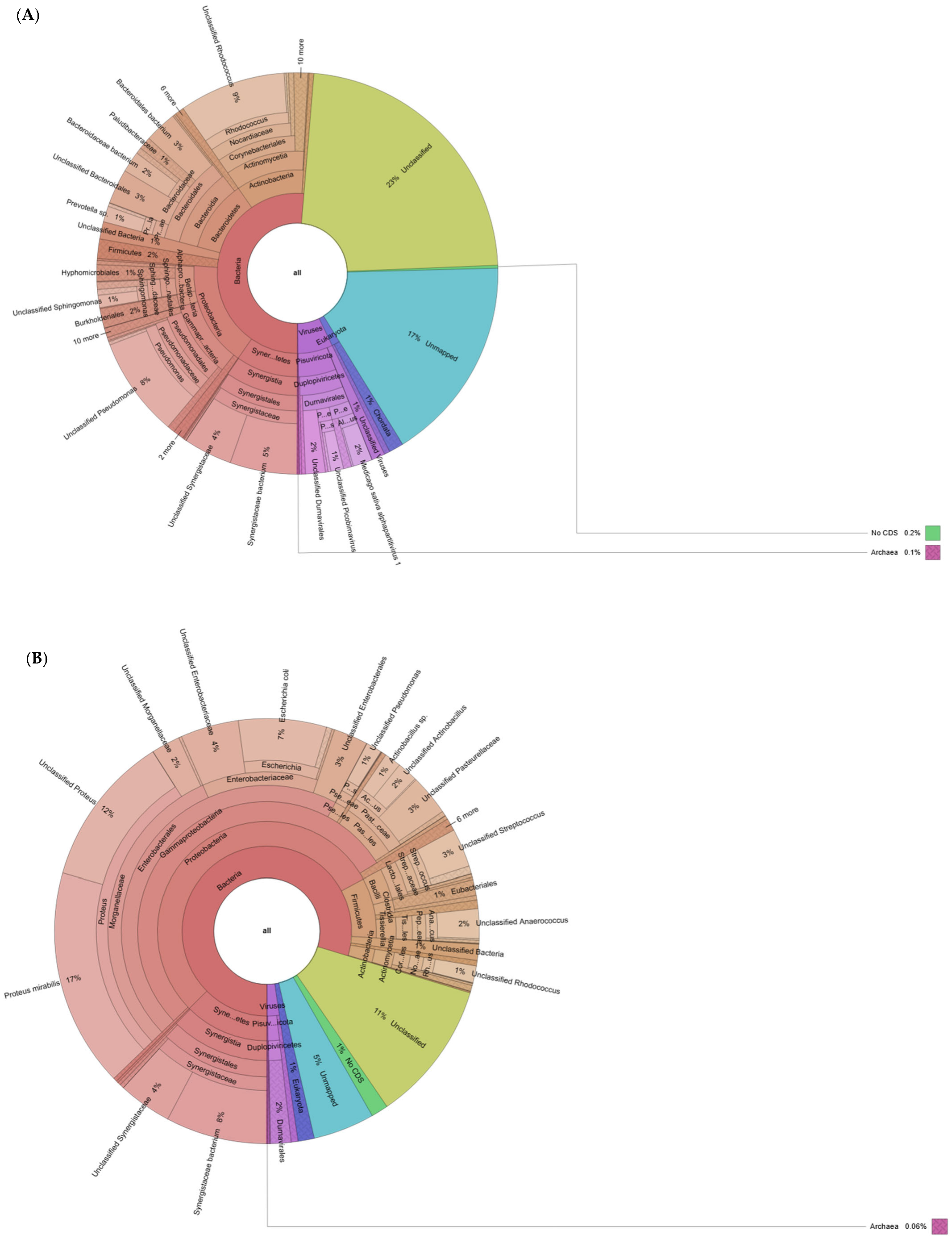

Appendix C
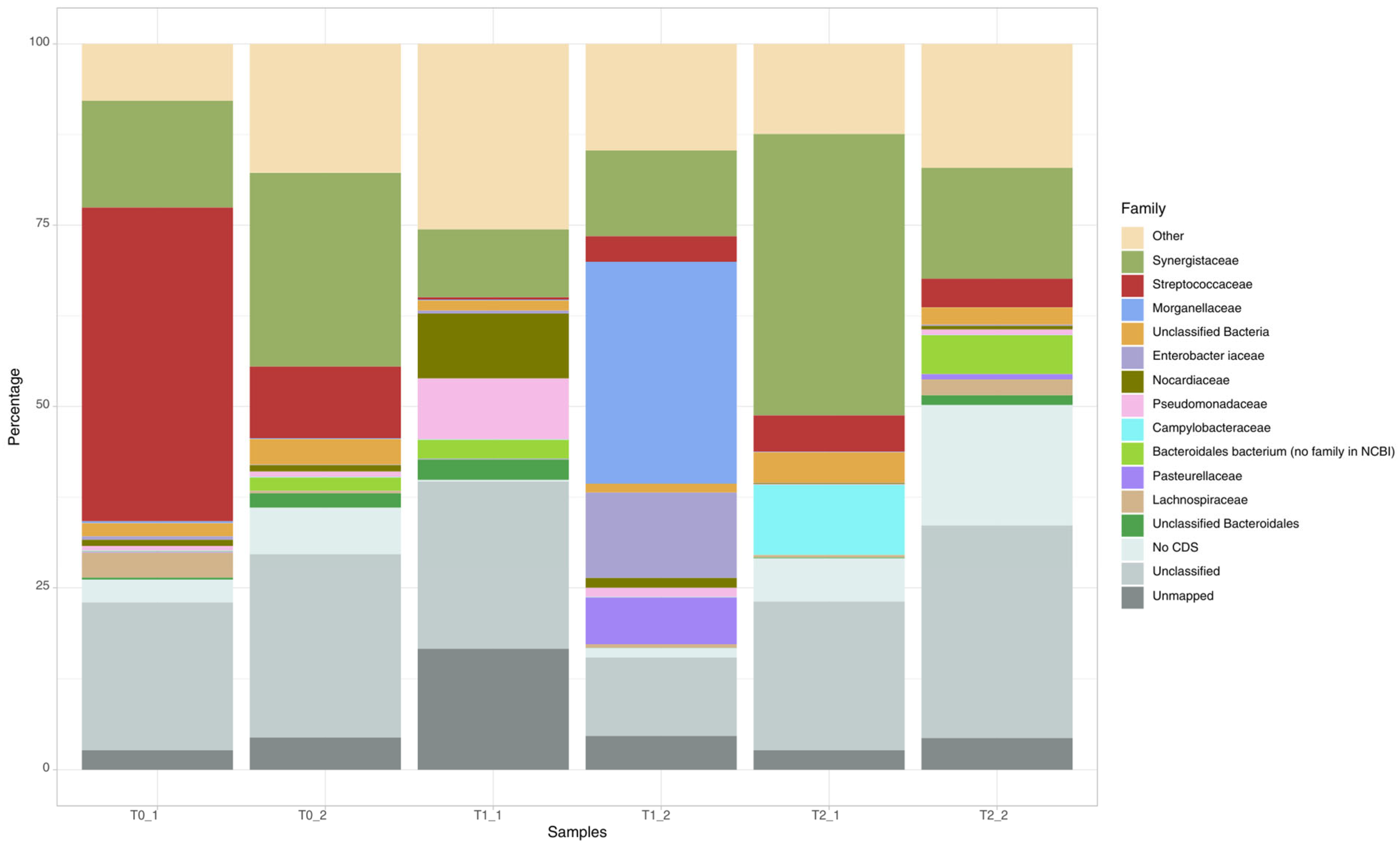
Appendix D
| Sample | Total Reads |
|---|---|
| T0_1 | 2.183 |
| T0_2 | 2.793 |
| T1_1 | 3.094 |
| T1_2 | 2.961 |
| T2_1 | 2.513 |
| T2_2 | 2.856 |
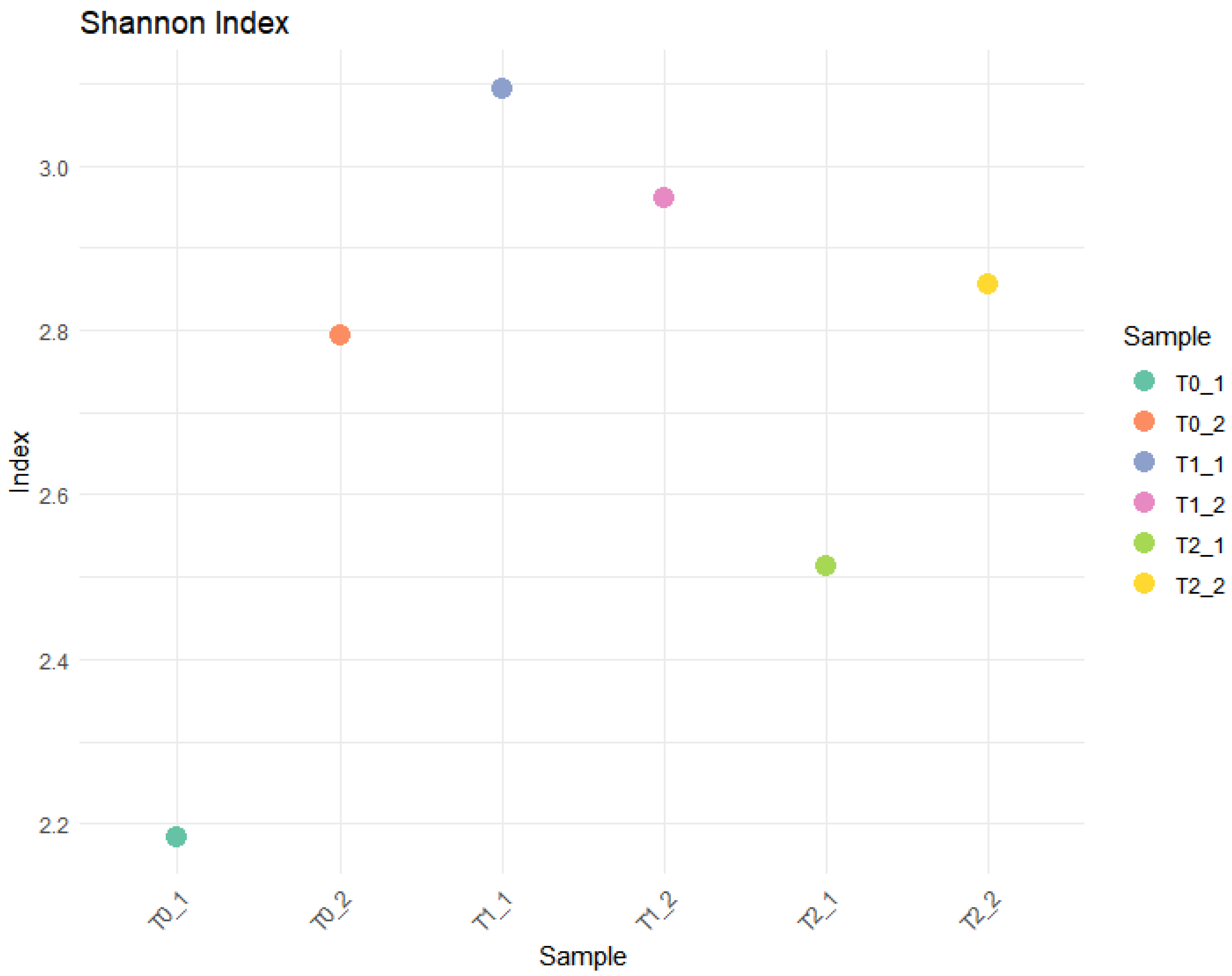
Appendix E

References
- Bodas, R.; Prieto, N.; García-González, S.A.; Giráldez, F.J.; López, S. Manipulation of rumen fermentation and methane production with plant secondary metabolites. Anim. Feed Sci. Technol. 2012, 176, 78–93. [Google Scholar] [CrossRef]
- Kamke, J.; Kittelman, S.; Soni, P.; Li, Y.; Tavendale, M.; Ganesh, S.; Janssen, P.H.; Shi, W.; Froula, J.; Rubin, E.M.; et al. Rumen metagenome and metatranscriptome analyses of low methane yield sheep reveals a Sharpea-enriched microbiome characterized by lactic acid formation and utilization. Microbiome 2016, 4, 56. [Google Scholar] [CrossRef] [PubMed]
- Abou-Elezz, K.; Samiento-Franco, L.; Santos-Ricalde, R.; Solorio-Sánchez, J.F. The nutritional effect of Moringa oleifera fresh leaves as feed supplement on Rhode Island Red hen egg production and quality. Trop. Anim. Health Prod. 2012, 44, 1035–1040. [Google Scholar] [CrossRef]
- Dey, A.; Paul, S.; Pandey, P.; Rathore, R. Potential of Moringa oleifera leaves in modulating in vitro methanogenesis and fermentation of wheat straw in buffalo. Indian J. Anim. Sci. 2014, 84, 533–538. [Google Scholar] [CrossRef]
- Shady, N.H.; Mostafa, N.M.; Fayez, S.; Abdel-Rahman, I.M.; Maher, S.A.; Zayed, A.; Saber, E.A.; Khowdiary, M.M.; Elrehany, M.A.; Alzubidi, M.A.; et al. Mechanistic Wound Healing and Antioxidant Potential of Moringa oleifera Seeds Extract Supported by Metabolic Profiling, In Silico Network Design, Molecular Docking, and In Vivo Studies. Antioxidants 2022, 11, 1743. [Google Scholar] [CrossRef] [PubMed]
- Söllinger, A.; Tviet, A.T.; Poulsen, M.; Noel, S.J.; Bengtsson, M.; Bernhardt, J.; Frydengahl-Hellwing, A.L.; Lund, P.; Riedel, K.; Schleper, C.; et al. Holistic Assessment of Rumen Microbiome Dynamics through Quantitative Metatranscriptomics Reveals Multifunctional Redundancy during Key Steps of Anaerobic Feed Degradation. mSystems 2018, 3, e00038-18. [Google Scholar] [CrossRef]
- Vasanth, K.; Minakshi, G.C.; Ilango, K.; Kumar, R.M.; Agrawal, A.; Dubey, G.P. Moringa oleifera attenuates the release of pro-inflammatory cytokines in lipopolysaccharide stimulated human monocytic cell line. Ind. Crops. Prod. 2015, 77, 44–50. [Google Scholar] [CrossRef]
- Morsy, T.A.; Gouda, G.A.; Kholif, A.E. In Vitro fermentation and production of methane and carbon dioxide from rations containing Moringa oleifera leave silage as a replacement of soybean meal. Environ. Sci. Pollut. Res. 2022, 29, 69743–69752. [Google Scholar] [CrossRef]
- Amad, A.A.; Zentek, J. The use of Moringa oleifera in ruminant feeding and its contribution to climate change mitigation. Front. Anim. Sci. 2023, 4, 1137562. [Google Scholar] [CrossRef]
- Lins, T.O.J.D.; Tery, S.A.; Silva, R.R.; Pereira, L.G.R.; Jancewicz, L.J.; He, M.L.; Wang, Y.; McAllister, T.A.; Chaves, A.V. Effects of the inclusion of Moringa oleifera seed on rumen fermentation and methane production in a beef cattle diet using the rumen simulation technique (Rusitec). Animal 2019, 13, 283–291. [Google Scholar] [CrossRef] [PubMed]
- Shakya, M.; Lo, C.C.; Chain, P.S.G. Advances and challenges in metatranscriptomic analysis. Front. Genet. 2019, 10, 904. [Google Scholar] [CrossRef]
- Zhang, Y.; Thompson, K.N.; Branck, T.; Yan, Y.; Nguyen, L.H.; Franzosa, E.A.; Huttenhower, C. Metatranscriptomics for the Human Microbiome and Microbial Community Functional Profiling. Annu. Rev. Biomed. Data Sci. 2021, 4, 279–311. [Google Scholar] [CrossRef] [PubMed]
- Parra-Garcia, A.; Elghandour, M.M.M.Y.; Greiner, R.; Barbosa-Pliego, A.; Camacho-Diaz, L.M.; Salem, Z.M. Effects of Moringa oleifera leaf extract on ruminal methane and carbon dioxide production and fermentation kinetics in a steer model. Environ. Sci. Pollut. Res. 2019, 26, 15333–15344. [Google Scholar] [CrossRef] [PubMed]
- Gómez-Chávez, J.A.; Castillo-Castillo, Y.; Castillo-Rangel, F.; Domínguez-Viveros, J.; Ordóñez-Baquera, P.L. Effect of Moringa oleifera on rumen fermentation in vitro and its impact on greenhouse gases. Rev. Mex. Cienc. Pecu. 2025, 16, 16–30. [Google Scholar] [CrossRef]
- Van-Soest, P.J.; Robertson, J.B.; Lewis, B.A. Methods for dietary fiber, neutral detergent fiber and non-starch polysaccharides in relation to animal nutrition. J. Dairy Sci. 1991, 74, 3583–3597. [Google Scholar] [CrossRef] [PubMed]
- AOAC. Official Methods of Analysis, 16th ed.; AOAC International, Association of Official Analytical Chemists: Gaithersburg, MD, USA, 1997. [Google Scholar]
- Thermo Fisher Scientific. RNAlater Stabilization Solution—Product Information Sheet. Available online: https://www.thermofisher.com/order/catalog/product/AM7020 (accessed on 3 August 2022).
- Thermo Fisher Scientific. PureLink™ RNA Mini Kit—Product Information Sheet. Available online: https://www.thermofisher.com/order/catalog/product/12183018A (accessed on 3 August 2022).
- Thermo Fisher Scientific. Qubit™ 4 Fluorometer User Guide; Publication No. MAN0017435. Available online: https://www.thermofisher.com/order/catalog/product/Q33238 (accessed on 3 August 2022).
- MGI Tech Co., Ltd. DNBSEQ-T7RS High-Throughput Sequencing Set User Manual; Version 9.0 (Publication No. 940-000270-00 y 940-000271-00 y 940-000272-00). MGI Technical Resources. Released 17 October 2024. Available online: https://en.mgi-tech.com/products/reagents_info/25/ (accessed on 15 December 2022).
- Illumina, Inc. NovaSeq 6000 Sequencing System Guide; Document No. 1000000019358, Version v16. Posted 13 October 2022. Available online: https://support.illumina.com/downloads/novaseq-6000-system-guide-1000000019358.html (accessed on 15 December 2022).
- Andrews, S. FastQC: A Quality Control Tool for High Throughput Sequence Data. 2010. Available online: https://www.bioinformatics.babraham.ac.uk/projects/fastqc/ (accessed on 3 April 2023).
- Ewles, P.; Magnusson, M.; Ludin, S.; Käller, M. MultiQC: Summarize analysis results for multiple tools and samples in a single report. Bioinformatics 2016, 32, 3047–3048. [Google Scholar] [CrossRef]
- Chen, S.; Zhou, Y.; Chen, Y.; Gu, J. Fastp: An ultra-fast all-in-one FASTQ preprocessor. Bioinformatics 2018, 34, 884–890. [Google Scholar] [CrossRef]
- Saeidipour, B.; Bakhshi, S. The relationship between organizational culture and knowledge management and their simultaneous effects on customer relation management. Adv. Environ. Biol. 2013, 7, 2803–2809. [Google Scholar]
- Bolger, A.M.; Lohse, M.; Usadel, B. Trimmomatic: A flexible trimmer for Illumina sequence data. Bioinformatics 2014, 30, 2114–2120. [Google Scholar] [CrossRef]
- Chen, S.; Huang, T.; Zhou, Y.; Han, Y.; Gu, J. AfterQC: Automatic filtering, trimming, error removing and quality control for fastq data. BMC Bioinform. 2017, 18, 80. [Google Scholar] [CrossRef]
- Hart, S.N.; Therneau, T.M.; Zhang, Y.; Poland, G.A.; Kocher, J.P. Calculating sample size estimates for RNA sequencing data. J. Comput. Biol. 2013, 20, 970–978. [Google Scholar] [CrossRef]
- Langmead, B.; Salzberg, S.L. Fast gapped-read alignment with Bowtie 2. Nat. Methods 2012, 9, 357–359. [Google Scholar] [CrossRef]
- U.S. National Center for Biotechnology Information (NCBI). 2023. Available online: https://www.ncbi.nlm.nih.gov/gene (accessed on 15 May 2023).
- Quast, C.; Pruesse, E.; Yilmaz, P.; Gerken, J.; Schweer, T.; Yarza, P.; Peplies, J.; Glöckner, F.O. The SILVA ribosomal RNA gene database project: Improved data processing and web-based tools. Nucleic Acids Res. 2013, 41, 590–596. [Google Scholar] [CrossRef] [PubMed]
- Tamames, J.; Puente-Sánchez, F. SqueezeMeta, a highly portable, fully automatic metagenomic analysis pipeline. Front. Microbiol. 2019, 24, 3349. [Google Scholar] [CrossRef]
- Kanehisa, M.; Sato, Y.; Kawashima, M.; Furumichi, M.; Tanabe, M. KEGG as a reference resource for gene and protein annotation. Nucleic Acids Res. 2016, 44, 457–462. [Google Scholar] [CrossRef] [PubMed]
- EMBL-EBI, PFAM DATA BASE 2023. Available online: http://pfam.xfam.org/ (accessed on 30 May 2023).
- Bushmanova, E.; Antipov, D.; Lapidus, A.; Prjibelski, A.D. RnaSPAdes: A de novo transcriptome assembler and its application to RNA-Seq data. Gigascience 2019, 8, giz100. [Google Scholar] [CrossRef]
- R Core Team. R: A Language and Environment for Statistical Computing, Version 4.2.2; R Foundation for Statistical Computing: Vienna, Austria, 2022; Available online: https://www.r-project.org/ (accessed on 30 May 2023).
- Puente-Sánchez, F.; García-García, N.; Tammames, J. SQMtools: Automated processing and visual analysis of ’omics data with R and anvi’o. BMC Bioinform. 2020, 21, 358. [Google Scholar] [CrossRef] [PubMed]
- Love, M.I.; Huber, W.; Anders, S. Moderated estimation of fold change and dispersion for RNA-seq data with DESeq2. Genome Biol. 2014, 15, 550. [Google Scholar] [CrossRef]
- Yu, G.; Chen, M. MicrobiomeProfiler: An R/Shiny Package for Microbiome Functional Enrichment Analysis. R Package Version 1.15.0. 2023. Available online: https://bioconductor.org/packages/MicrobiomeProfiler (accessed on 30 May 2023).
- Korotkevich, G.; Sukhov, V.; Sergushichev, A. Fast gene set enrichment analysis. bioRxiv 2019. [Google Scholar] [CrossRef]
- Mann, E.; Wetzels, S.U.; Wagner, M.; Zebeli, Q.; Schmitz-Esser, S. Metatranscriptome sequencing reveals insights into the gene expression and functional potential of rumen wall bacteri. Front. Microbiol. 2018, 23, 43. [Google Scholar]
- Cantalapiedra, C.P.; Hernández-Plaza, A.; Letunic, I.; Bork, P.; Huerta-Cepas, J. eggNOG-mapper v2: Functional Annotation, Orthology Assignments, and Domain Prediction at the Metagenomic Scale. Mol. Biol. Evol. 2021, 38, 5825–5829. [Google Scholar] [CrossRef] [PubMed]
- Sergushvichev, A.A. An algorithm for fast preranked gene set enrichment analysis using cumulative statistic calculation. bioRxiv 2016. [Google Scholar] [CrossRef]
- Kaplan-Shabtai, V.; Indugu, N.; Hannessy, M.L.; Vecchiarelli, B.; Bender, J.S.; Stefanovski, D.; De Asis-Lage, C.F.; Räisänen, S.E.; Melgar, A.; Nedelkov, K.; et al. Using Structural Equation Modeling to Understand Interactions Between Bacterial and Archaeal Populations and Volatile Fatty Acid Proportions in the Rumen. Front. Microbiol. 2021, 12, 611951. [Google Scholar] [CrossRef] [PubMed]
- Iliyasu, D.; Rwuaan, J.S.; Sani, D.; Nwannenna, A.I.; Njoku, C.O.; Mustapha, A.R.; Peter, I.D. Evaluation of Safety, Proximate and Efficacy of Graded Dose of Moringa oleifera Aqueous Seed Extract as Supplement That Improve Live-Body Weight and Scrotal Circumference in Yankasa Ram. Int. J. Livest. Res. 2020, 10, 33–46. [Google Scholar] [CrossRef]
- Patra, A.K.; Saxena, J. A new perspective on the use of plant secondary metabolites to inhibit methanogenesis in the rumen. Phytochemistry 2010, 71, 1198–1222. [Google Scholar] [CrossRef]
- Galperin, M.Y. Genome Diversity of Spore-Forming Firmicutes Bacterial systematics from Gram stain to 16S rRNA. Microbiol. Spectr. 2013, 1, 1–27. [Google Scholar] [CrossRef]
- Guo, G.; Shen, G.; Liu, Q.; Zhang, S.L.; Wang, C.; Chen, L.; Xu, Q.F.; Wang, Y.X.; Huo, W.J. Fermentation quality and in vitro digestibility of first and second cut alfalfa (Medicago sativa L.) silages harvested at three stages of maturity. Anim. Feed. Sci. Technol. 2019, 257, 114274. [Google Scholar] [CrossRef]
- Russell, J. Rumen Microbiology and Its Role in Ruminant Nutrition; Cornell University Press: Ithaca, NY, USA, 2002; p. 121. [Google Scholar]
- Oliveira, I.M.F.; Godoy-Santos, F.; Boniface-Oyoma, L.; Magalhaes-Moreira, S.; Gonzalves-Dias, R.; Huws, S.A.; Creevey, C.J.; Cuquetto-Mantovani, H. Whole-Genome Sequencing and Comparative Genomic Analysis of Antimicrobial Producing Streptococcus lutetiensis from the Rumen. Microorganisms 2022, 10, 551. [Google Scholar] [CrossRef]
- Mulakala, B.K.; Smith, K.M.; Snider, M.A.; Ayres, A.; Honan, M.C.; Greenwood, S.L. Influence of dietary carbohydrate profile on the dairy cow rumen meta-proteome. J. Dairy Sci. 2022, 105, 8485–8496. [Google Scholar] [CrossRef] [PubMed]
- Hernández, R.; Chaib-De Mares, M.; Jimenez, H.; Reyes, A.; Caro-Quintero, A. Functional and Phylogenetic Characterization of Bacteria in Bovine Rumen Using Fractionation of Ruminal Fluid. Front. Microbiol. 2022, 13, 813002. [Google Scholar] [CrossRef]
- Seshadri, R.; Leahy, S.C.; Attwood, G.T.; Teh, K.H.; Lambie, S.C.; Cookson, A.L.; Eloe-Fadrosh, E.A.; Pavlopoulos, G.A.; Hadjithomas, M.; Varghese, N.J.; et al. Cultivation and sequencing of rumen microbiome members from the Hungate1000 Collection. Nat. Biotechnol. 2018, 36, 359–367. [Google Scholar] [CrossRef] [PubMed]
- Akintokun, A.; Adeyosoye, O.; Abiola-Olagunju, O.; Joel, E. Identification and Occurrence of Heterophilic Rumen Bacteria and Fungi Isolated from Selected Nigerian Breeds of Cattle. Appl. Environ. Microbiol. 2014, 2, 303–308. [Google Scholar]
- Bansal, S.; Goel, G. Commercial Application of Rumen Microbial Enzymes. In Rumen Microbiology: From Evolution to Revolution; Springer: New Delhi, India, 2015; pp. 281–291. [Google Scholar]
- Oyeyinka, A.T.; Adebo, O.A.; Siwela, M.; Pillay, K. Dataset on effect of decolourisation on metabolomic profile of Moringa oleifera leaf powder. Data Br. 2022, 44, 108508. [Google Scholar] [CrossRef] [PubMed]
- Rosenberg, E.; De Long, E.F.; Lory, S.; Stackebrandt, E.; Thompson, F. The Prokaryotes: Other Major Lineages of Bacteria and the Archaea; Springer: Berlin/Heidelberg, Germany, 2014; pp. 1–1028. [Google Scholar]
- Harvey, K.L.; Jarocki, V.M.; Charles, I.G.; Djordjevic, S.P. The diverse functional roles of elongation factor tu (Ef-tu) in microbial pathogenesis. Front. Microbiol. 2019, 10, 2351. [Google Scholar] [CrossRef]
- Budkina, K.S.; Zlobin, N.E.; Kononova, S.V.; Ovchinnikov, L.P.; Babakov, A.V. Cold Shock Domain Proteins: Structure and Interaction with Nucleic Acids. Biochemistry 2020, 18, S1–S19. [Google Scholar] [CrossRef]
- Xie, F.; Jin, W.; Si, H.; Tao, Y.; Liu, J.; Yang, C.; Li, Q.; Yan, X.; Lin, L.; Jiang, Q.; et al. An integrated gene catalog and over 10,000 metagenome-assembled genomes from the gastrointestinal microbiome of ruminants. Microbiome 2021, 9, 137. [Google Scholar] [CrossRef]
- Almirón, M.; Link, A.J.; Furlong, D.; Kolter, R. A novel DNA-binding protein with regulatory and protective roles in starved Escherichia coli. Genes. Dev. 1992, 6, 2646–2654. [Google Scholar] [CrossRef]
- Wu, T.; Hu, E.; Xu, S.; Chen, M.; Guo, P.; Dai, Z.; Feng, T.; Zhou, L.; Tang, W.; Zhan, L.; et al. clusterProfiler 4.0: A universal enrichment tool for interpreting omics data. Innovation 2021, 2, 100141. [Google Scholar] [CrossRef]
- Wu, M.C.; Lin, X. Prior biological knowledge-based approaches for the analysis of genome-wide expression profiles using gene sets and pathways. Bone 2008, 23, 577–593. [Google Scholar] [CrossRef]
- McDonald, P.; Edwards, R.A.; Greenhalgh, J.F.D.; Morgan, C.A.; Sinclair, L.A.; Wilkinson, R.G. Animal Nutrition, 7th ed.; Pearson Education Limited: Harlow, UK, 2018; p. 752. [Google Scholar]
- Lakhanin, N.; Lakhani, P.; Sheikh, A.; Bhagat, R.; Rashid-Dar, R.; Dogra, P. Methanogenesis: Are ruminants only responsible: A review. J. Pharmacogn. Phytochem. 2017, 6, 2347–2352. [Google Scholar]
- Tseten, T.; Sanjorjo, R.A.; Kwon, M.; Kim, S.W. Strategies to Mitigate Enteric Methane Emissions from Ruminant Animals. J. Microbiol. Biotechnol. 2022, 32, 269–277. [Google Scholar] [CrossRef] [PubMed]
- Daulai, M.S. Evaluation of anti-methanogenic compound and phytogenic extract of Moringa oleifera on ruminal methane production. In Nutrition and Feed Science Study Program; IPB University: Bogor, Indonesia, 2024. [Google Scholar]
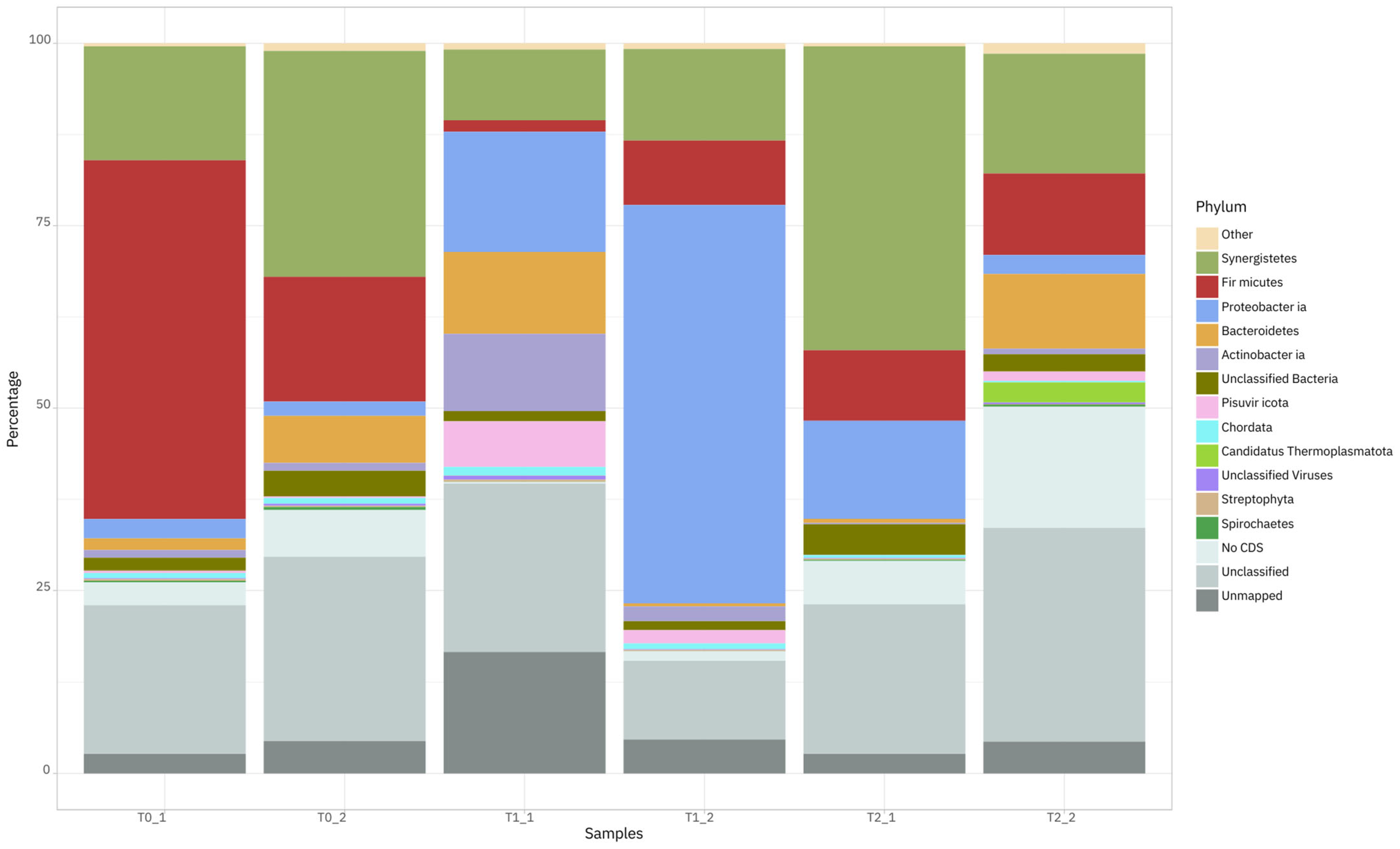

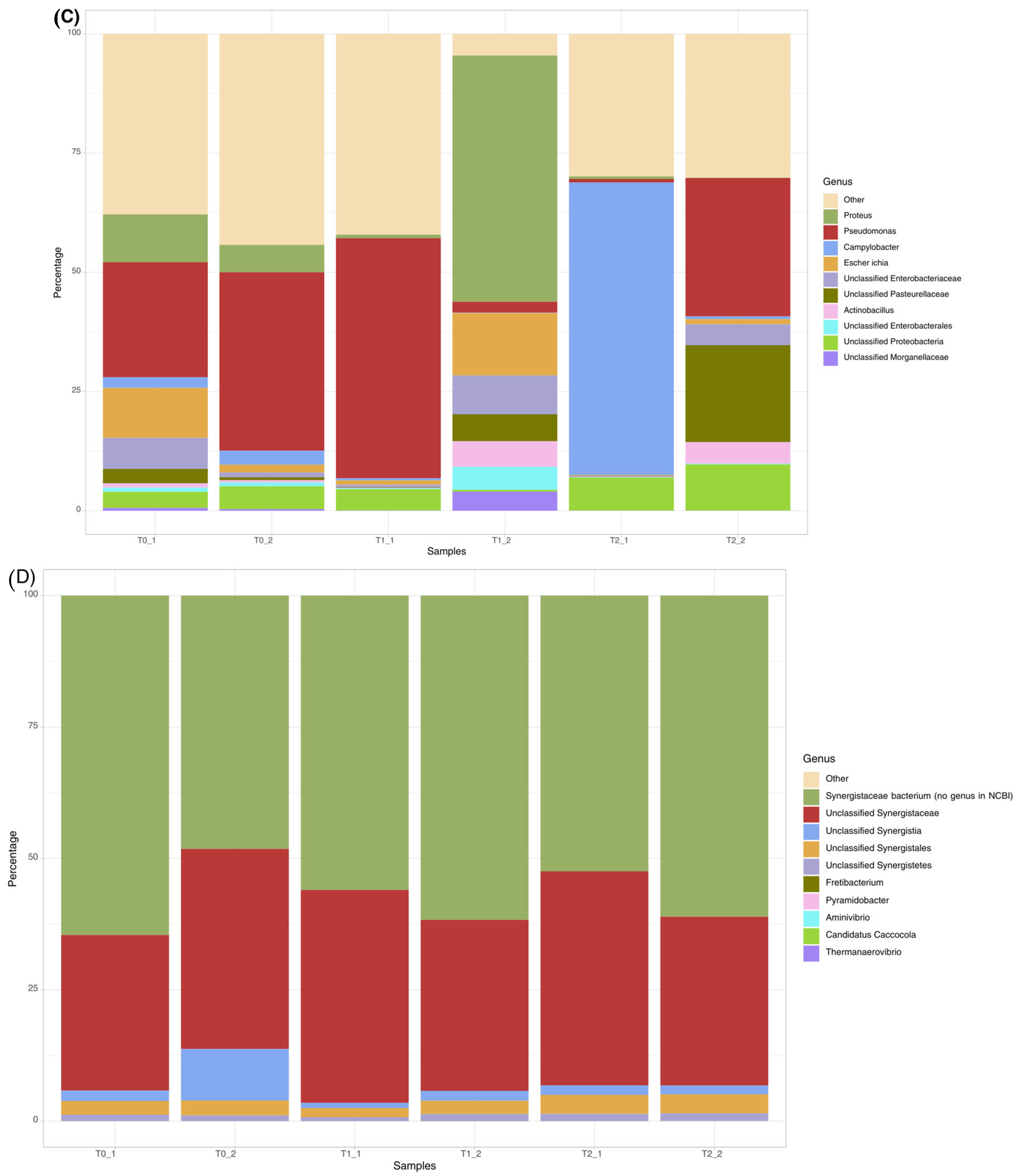


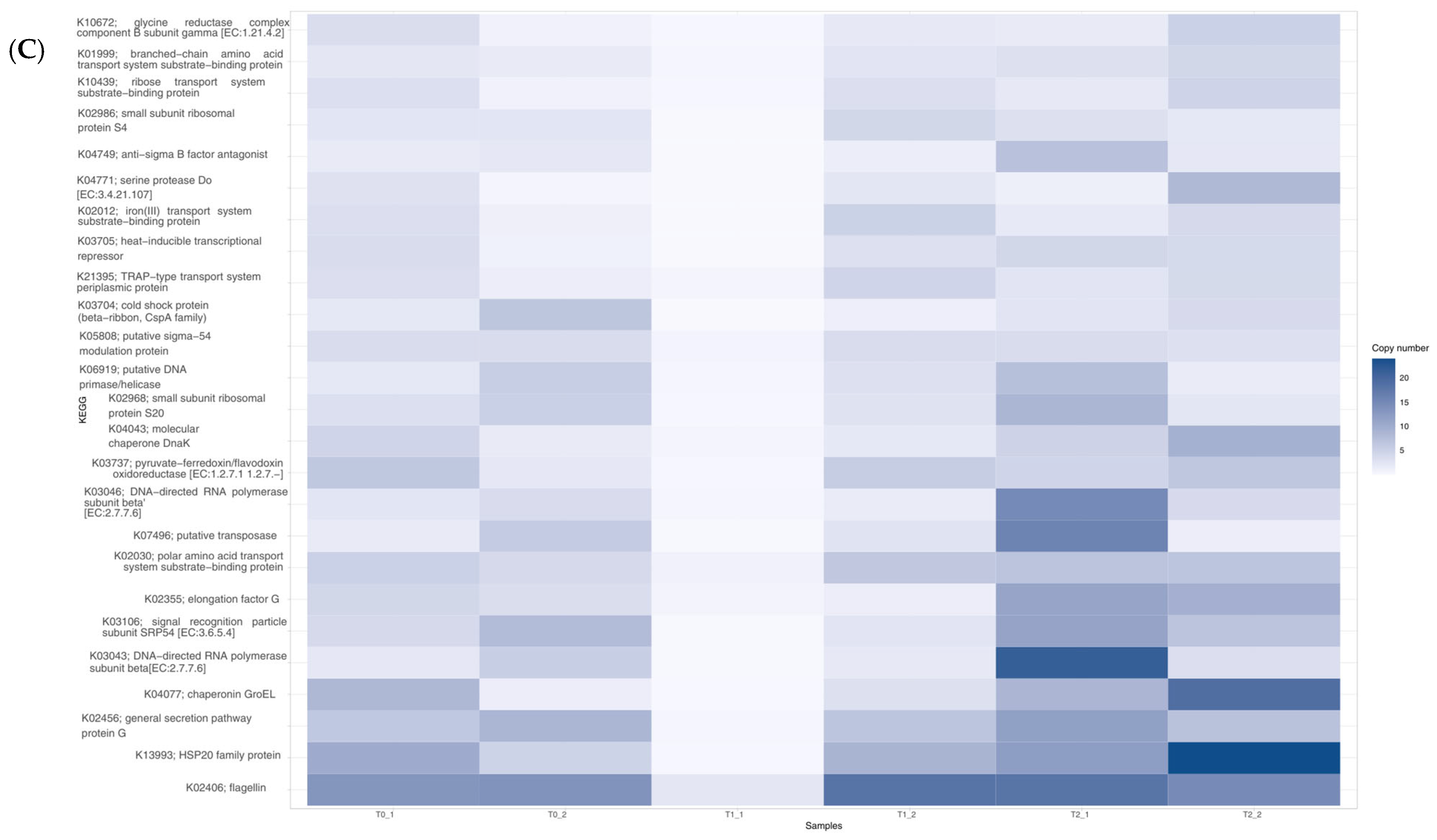


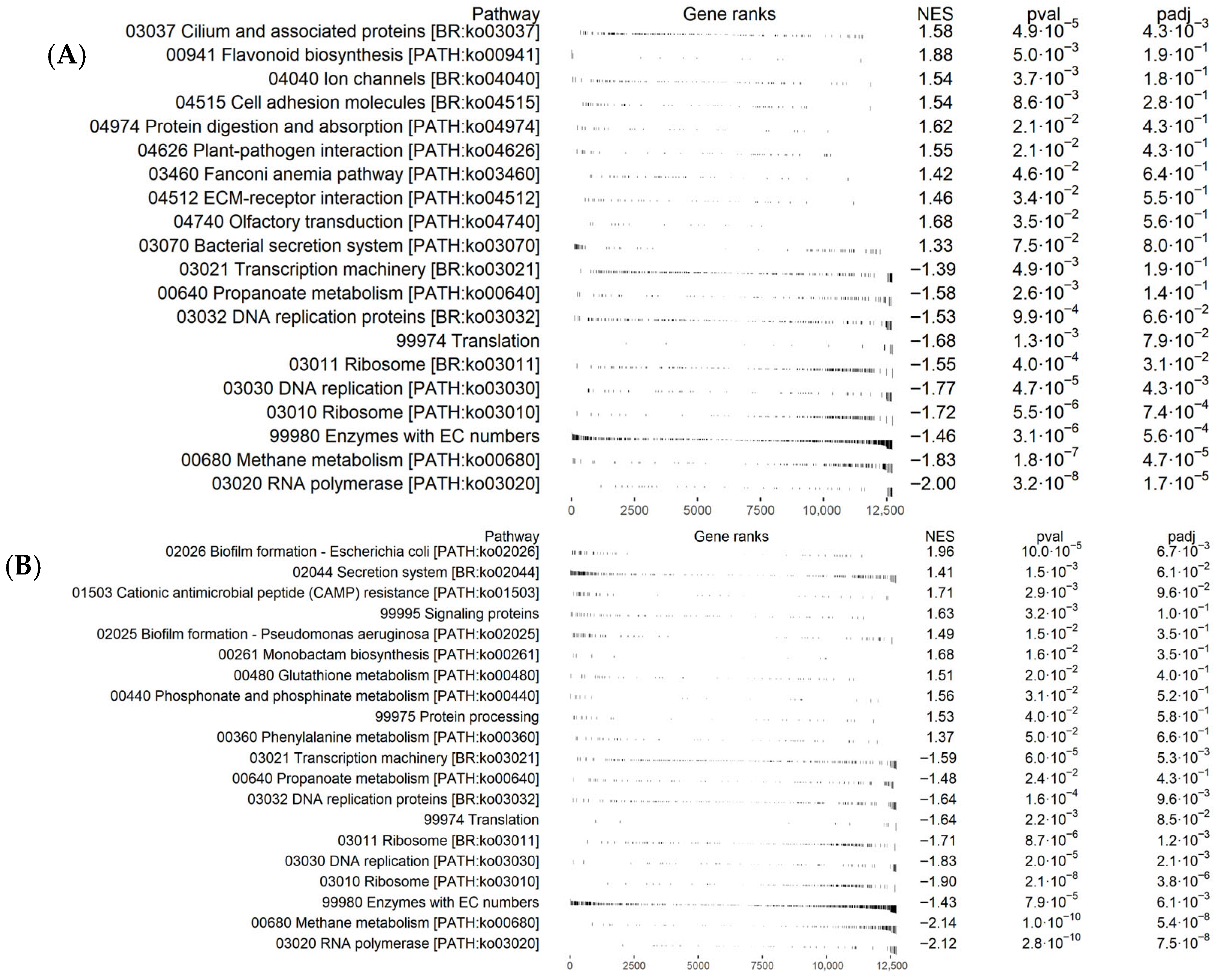
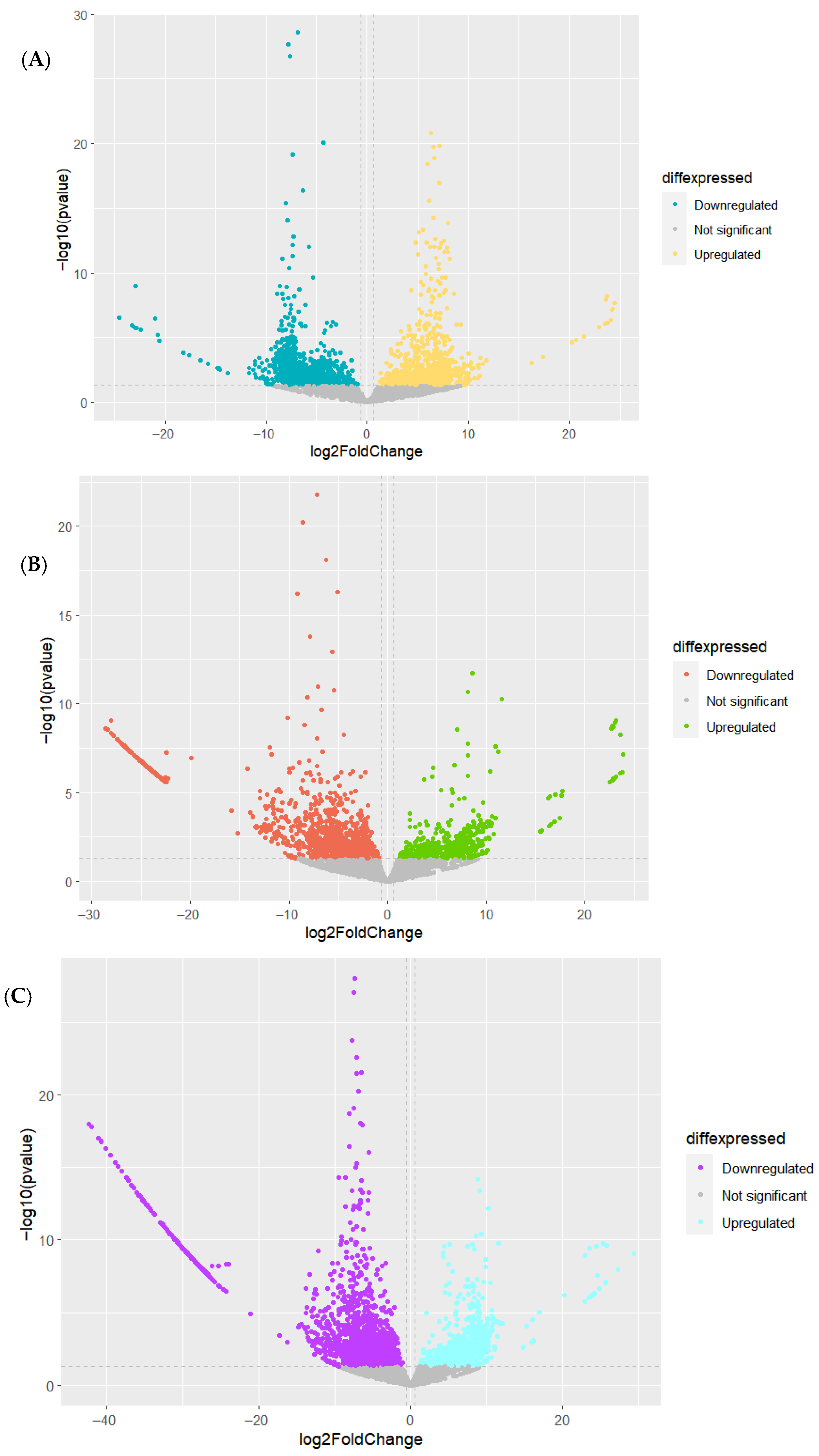

| Variable | CA | MB | MA | p-Value |
|---|---|---|---|---|
| pH | 6.74 a | 6.86 a | 6.76 a | ≥0.05 |
| DM Digestibility (%) | 63.88 a | 66.65 ab | 67.87 b | <0.05 |
| Neutral detergent fiber (%) | 24.64 a | 30.96 ab | 32.09 b | <0.01 |
| Acid detergent fiber (%) | 17.80 a | 22.53 ab | 23.54 b | <0.01 |
| Gas production (mL/g) | 49.06 a | 51.18 ab | 55.93 b | <0.05 |
| Acetic acid (mmol/L) | 63.9 a | 42.3 b | 31.2 c | <0.05 |
| Propionic acid (mmol/L) | 30.6 a | 21.0 b | 11.1 c | <0.05 |
| Butyric acid (mmol/L) | 9.3 a | 4.6 b | 4.2 b | <0.05 |
| TAGV (mmol/L) | 103.9 a | 67.9 b | 46.5 c | <0.05 |
| CO2 (% molar) | 51.7 a | 48.5 b | 51.9 a | <0.05 |
| CH4 (% molar) | 28.6 a | 26.0 b | 32.3 c | <0.05 |
| NH3 (mmol/mL) | 14.6 a | 14.9 a | 15.1 a | >0.05 |
| Sample | Total Reads | Mapped Reads | Mapping Percentage | Total Bases per Sample |
|---|---|---|---|---|
| T0_1 | 73,182,222 | 71,214,334 | 97.31 | 10,785,232,234 |
| T0_2 | 76,371,052 | 72,968,710 | 95.54 | 11,281,335,036 |
| T1_1 | 61,435,340 | 51,225,045 | 83.38 | 8,963,537,084 |
| T1_2 | 76,655,916 | 73,071,611 | 95.32 | 11,286,729,809 |
| T2_1 | 86,043,460 | 83,726,582 | 97.31 | 12,555,046,099 |
| T2_2 | 82,559,420 | 78,956,090 | 95.64 | 12,176,189,504 |
| Overall values | 456,247,410 | 431,162,372 | Media% = 94.083 | 67,048,069,766 |
Disclaimer/Publisher’s Note: The statements, opinions and data contained in all publications are solely those of the individual author(s) and contributor(s) and not of MDPI and/or the editor(s). MDPI and/or the editor(s) disclaim responsibility for any injury to people or property resulting from any ideas, methods, instructions or products referred to in the content. |
© 2025 by the authors. Licensee MDPI, Basel, Switzerland. This article is an open access article distributed under the terms and conditions of the Creative Commons Attribution (CC BY) license (https://creativecommons.org/licenses/by/4.0/).
Share and Cite
Grijalva-Hinojos, A.A.; Arnau, V.; Díaz, W.; Piquer, S.; Díaz-Plascencia, D.; Castillo-Castillo, Y.; Domínguez-Viveros, J.; Ordoñez-Baquera, P.L. Metatranscriptome Analysis of Sheep Rumen Reveals Methane Production Changes Induced by Moringa oleifera as a Dietary Supplement. Fermentation 2025, 11, 568. https://doi.org/10.3390/fermentation11100568
Grijalva-Hinojos AA, Arnau V, Díaz W, Piquer S, Díaz-Plascencia D, Castillo-Castillo Y, Domínguez-Viveros J, Ordoñez-Baquera PL. Metatranscriptome Analysis of Sheep Rumen Reveals Methane Production Changes Induced by Moringa oleifera as a Dietary Supplement. Fermentation. 2025; 11(10):568. https://doi.org/10.3390/fermentation11100568
Chicago/Turabian StyleGrijalva-Hinojos, Alicia Alejandra, Vicente Arnau, Wladimiro Díaz, Samuel Piquer, Daniel Díaz-Plascencia, Yamicela Castillo-Castillo, Joel Domínguez-Viveros, and Perla Lucia Ordoñez-Baquera. 2025. "Metatranscriptome Analysis of Sheep Rumen Reveals Methane Production Changes Induced by Moringa oleifera as a Dietary Supplement" Fermentation 11, no. 10: 568. https://doi.org/10.3390/fermentation11100568
APA StyleGrijalva-Hinojos, A. A., Arnau, V., Díaz, W., Piquer, S., Díaz-Plascencia, D., Castillo-Castillo, Y., Domínguez-Viveros, J., & Ordoñez-Baquera, P. L. (2025). Metatranscriptome Analysis of Sheep Rumen Reveals Methane Production Changes Induced by Moringa oleifera as a Dietary Supplement. Fermentation, 11(10), 568. https://doi.org/10.3390/fermentation11100568






